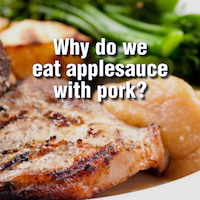by Carol L. Cheatham, PhD
Associate Professor of Psychology and Neuroscience
UNC Nutrition Research Institute
Kannapolis, NC
Have you ever wondered why we eat certain foods together? What is it about pork that demands applesauce? Wouldn’t a lovely piece of hard cheese go well with that glass of red wine? Is beef and broccoli just a dish or might there be a benefit to eating those together? It is difficult to trace how these traditional pairings got started. Apples with pork dates back to the time of Christ when an Ancient Roman named Apicius wrote down a recipe, but where did he get the idea? We find a clue in the story of why we eat mint with lamb. In an attempt to decrease the consumption of lamb and thereby increase wool exports, Queen Elizabeth I declared it unlawful to eat lamb without mint sauce, presumably because people disliked the taste of mint sauce (basically mint and vinegar). As it turned out, mint sauce was a great compliment to lamb. So, yes. Your first instinct was correct – we eat certain foods together because they taste good together!
Thus, a better question might be why do certain foods taste so good together? Most likely, because they were intended to be eaten together. Certain characteristics of foods lend themselves to pairings with other foods of certain characteristics. Think about the combination of pork and apples; lamb and mint sauce; and wine and cheese. What do they have in common? They are all something fatty with something tart. You may have heard that the tartness “cuts the fat,” but what does that mean? It is noticeable in your mouth – the “slipperiness” of the fat is reduced by the “puckeriness” of the tart food. So, the fatty food becomes more palatable or simply, tastes good with the paired food.
Why would this be? If these foods are intended to be eaten together, what is the reason? Certainly this is a complex matter with many answers; here I offer just one. As it turns out, fatty acids need the nutrients in the paired foods to help them meet their goals, and possibly, vice versa. Fatty acids are very important to the brain, but they have a couple challenges – they are subject to oxidation, and they are stored in the liver. Therefore, if a fatty acid wants to get to the brain, it needs antioxidants to insure that it is delivered to the brain intact. The antioxidant activity of natural vitamin E and the carotenoid lutein have been shown to protect the supply of docosahexaenoic acid (DHA) in the brain. In fact, fatty acids are so reliant on nutrients with antioxidant activity that they act in the body to increase the bioavailability of them. For example, carotenoids are antioxidants. In a study conducted at Ohio State University, it was shown that eating avocado – a great source of fatty acids – with salsa increased the absorption of the carotenoids lycopene and beta-carotene from the salsa by 4.4 times and 2.6 times, respectively, when compared to eating salsa alone (Unlu, Bohn, Clinton, & Schwartz, 2005). Thus, without the fatty acids, the antioxidants would not be as highly absorbed, and without the antioxidants, the fatty acids would be oxidized and thus, unable to fulfill their role in the brain. This relationship is called synergy.
Other nutrients exhibit similar properties. Iron is better absorbed by the body in the presence of vitamin C. So, one would want to eat red meat, which is rich in iron, with sources of vitamin C (e.g., beef and broccoli). For vegetarians, this synergy can be found in things such as spinach (iron) and strawberry (vitamin C) salad. As another example, bones are protected by a similar synergy: when the minerals that build bones (calcium, phosphorus, and magnesium) are in short supply, vitamin D steps in to insure that the bones stay strong. To facilitate this synergistic activity, one only needs to expose the skin (without sunscreen) to sunshine. Yes, simply playing outdoors can strengthen bones.
There are many other instances of foods working together, but it is also the case that nutrients that work together appear in nature together. The B vitamins work best when they are consumed together, and they generally appear in foods together; so much so that they were once thought to be one vitamin. Moreover, for water soluble vitamins like vitamin C, it is important that the fiber in the vitamin C food be present to slow it down so that the vitamin C can be absorbed. To continue with the previous example from food pairings, many fatty acid foods contain also the antioxidants that the fatty acids need for protection. Salmon and beef liver, for example, contain fatty acids and vitamin E. For these and many other reasons, it is important to eat whole foods: the food matrix is very important to the synergistic activity of nutrients.
Bottom line, to get the most out of the foods we eat, we should eat whole foods (i.e., not processed foods), and we should eat vegetables with fatty foods. To hear more on this topic, please enjoy my Appetite for Life presentation, which can be found here.
Unlu, N.Z., Bohn, T., Clinton, S.K., & Schwartz, S.J. (2005). Carotenoid absorption from salad and salsa by humans is enhanced by the addition of avocado or avocado oil. Human Nutrition & Metabolism, 144; 431-436.

